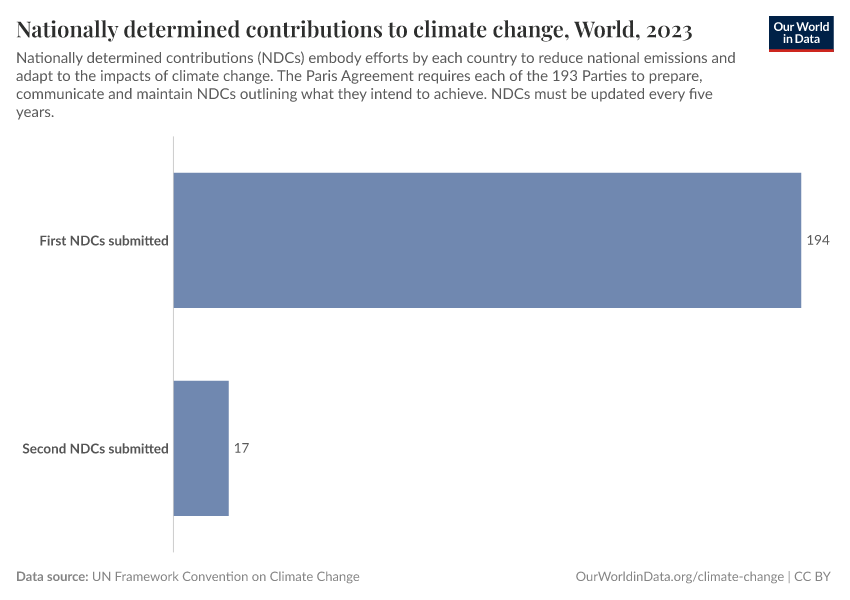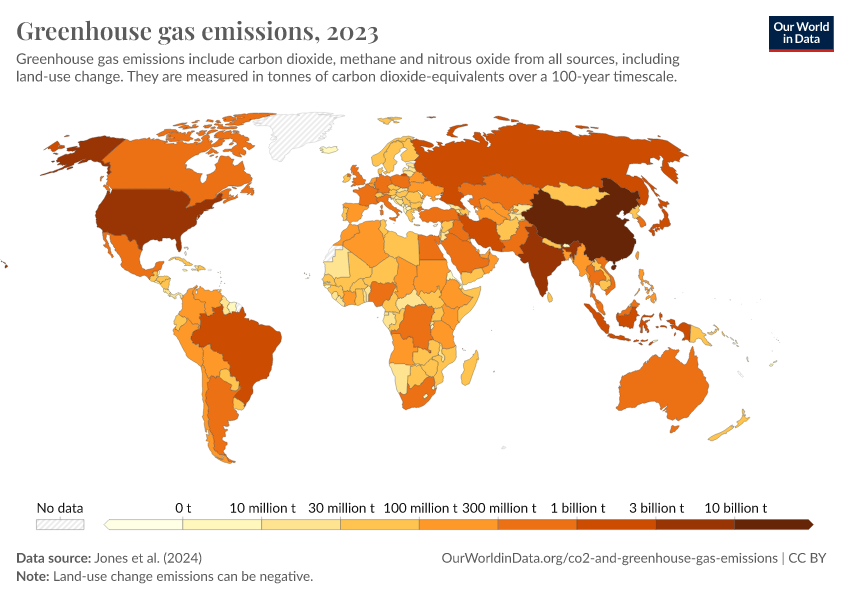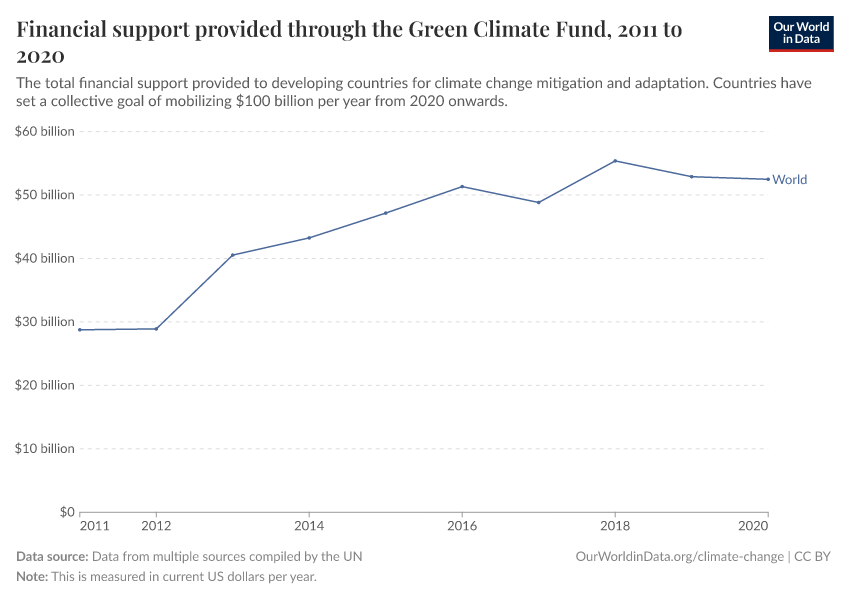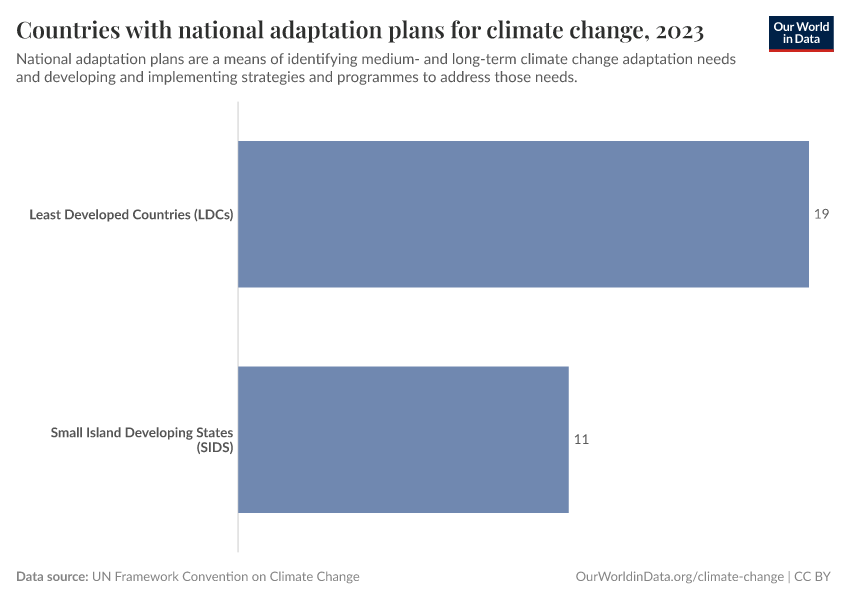Sustainable Development Goal 13
Take urgent action to combat climate change and its impacts
Sustainable Development Goal 13 is to “take urgent action to combat climate change and its impacts”, according to the United Nations.
The visualizations and data below present the global perspective on where the world stands today and how it has changed over time. Further data and statistics can be found at the Our World in Data topic pages on CO2 and Greenhouse Gas Emissions and Climate Change.
The UN has defined 5 targets and 8 indicators for SDG 13. Targets specify the goals and indicators represent the metrics by which the world aims to track whether these targets are achieved. Below we quote the original text of all targets and show the data on the agreed indicators.
List of targets and indicators
Target 13.1Strengthen resilience and adaptive capacity to climate-related disasters
SDG Indicator 13.1.1Deaths and injuries from natural disasters
Definition of the SDG indicator: Indicator 13.1.1 is the “number of deaths, missing persons and directly affected persons attributed to disasters per 100,000 population” in the UN SDG framework.
In the interactive visualizations, we show a range of metrics that capture human impacts and losses from natural disasters.
The first chart shows the rate of deaths and missing persons from natural disasters. This is followed by a series of charts on deaths, injuries, homelessness, and displacement from disasters.
Target: By 2030 “strengthen resilience and adaptive capacity to climate-related hazards and natural disasters in all countries.”
More research: Further data and research on this topic can be found at the Our World in Data topic page on Natural Disasters.

SDG Indicator 13.1.2National disaster risk management
Definition of the SDG indicator: Indicator 13.1.2 is the “number of countries that adopt and implement national disaster risk reduction strategies in line with the Sendai Framework for Disaster Risk Reduction 2015–2030” in the UN SDG framework.
This indicator identifies countries who have and have not adopted and implemented disaster risk management strategies in line with the Sendai Framework for Disaster Risk Reduction.
The Sendai Framework for Disaster Risk Reduction 2015-2030 is an international agreement that aims to strengthen disaster preparedness in order to reduce risk and losses from disasters. Although the indicator definition is framed in terms of the number of countries adopting national disaster risk reduction strategies in line with the Sendai Framework, the United Nations tracks this measure in terms of country levels of implementation.
The interactive visualization here shows levels of country implementation, on a scale from 0 to 1 (where the higher score, the more policies have been implemented). It’s based on an average score from 10 sub-indicators that collectively reflect progress towards implementation of the Sendai Framework.
Target: By 2030 “strengthen resilience and adaptive capacity to climate-related hazards and natural disasters in all countries.”
More research: Further data and research on this topic can be found at the Our World in Data topic page on Natural Disasters.
Additional charts

SDG Indicator 13.1.3Local disaster risk management
Definition of the SDG indicator: Indicator 13.1.3 is the “proportion of local governments that adopt and implement local disaster risk reduction strategies in line with national disaster risk reduction strategies” in the UN SDG framework.
In this context, “local governments” refers to sub-national administrative bodies that have responsibility for developing disaster risk reduction strategies.
The number of these local administrations that have adopted disaster risk reduction strategies in line with national strategies are shown in the interactive visualization.
Target: By 2030 “strengthen resilience and adaptive capacity to climate-related hazards and natural disasters in all countries.”
More research: Further data and research on this topic can be found at the Our World in Data topic page on Natural Disasters.

Target 13.2Integrate climate change measures into policy and planning
SDG Indicator 13.2.1Integration of climate change into national policies
Definition of the SDG indicator: Indicator 13.2.1 is the “number of countries with nationally determined contributions, long-term strategies, national adaptation plans and adaptation communications, as reported to the secretariat of the United Nations Framework Convention on Climate Change” in the UN SDG framework.
National commitments within the UNFCCC Paris Agreement vary by country depending on their Nationally Determined Contributions (NCDs) so are not directly comparable.
In the interactive chart you can see the number of countries that have submitted nationally determined contributions (NDCs). In the additional charts below you will find data on national CO2 emissions, per capita emissions and carbon intensity measures to track progress on emissions reductions.
Target: By 2030 “integrate climate change measures into national policies, strategies and planning.”
More research: Further data and research on this topic can be found at the Our World in Data topic page on CO2 and Other Greenhouse Gas Emissions.

SDG Indicator 13.2.2Total greenhouse gas emissions per year
Definition of the SDG indicator: Indicator 13.2.2 is the “total greenhouse gas emissions per year” in the UN SDG framework.
The ultimate aim of the United Nations Climate Change Convention is to achieve the stabilization of greenhouse gas (GHG) concentrations in the atmosphere at a level that would prevent dangerous anthropogenic interference with the climate system.
GHG emissions are measure in terms of carbon dioxide equivalents because each greenhouse gas has a different warming effects: one tonne of methane does not have the same impact on warming as one tonne of CO2. Carbon dioxide equivalents (CO2e) attempt to convert the warming impact of the range of greenhouse gases into a single metric.
Target: By 2030 “integrate climate change measures into national policies, strategies and planning.”
More research: Further data and research on this topic can be found at the Our World in Data topic page on Greenhouse Gas Emissions.
Additional charts

Target 13.3Build knowledge and capacity to meet climate change
SDG Indicator 13.3.1Education on climate change
Definition: Indicator 13.3.1 is the “extent to which (i) global citizenship education and (ii) education for sustainable development are mainstreamed in (a) national education policies; (b) curricula; (c) teacher education; and (d) student assessment” in the UN SDG framework.
Responses are submitted by national governments – often the Ministry of Education – after consulting across other government ministries, with national human rights institutes, the education sector, and civil society organizations.
National governments submit notes on policies and programmes that facilitate global citizenship education across these groups. They are also asked to provide evidence of these interventions.
The major limitation of this measure is that it is self-reported by national governments.
Target: By 2030 “improve education, awareness-raising and human and institutional capacity on climate change mitigation, adaptation, impact reduction and early warning.”

Target 13.aImplement the UN Framework Convention on Climate Change
SDG Indicator 13.a.1Green Climate Fund mobilization of $100 billion
Definition of the SDG indicator: Indicator 13.a.1 is the “amounts provided and mobilized in United States dollars per year in relation to the continued existing collective mobilization goal of the $100 billion commitment through to 2025” in the UN SDG framework.
This indicator measures the current pledged commitments from countries to the Green Climate Fund (GCF) as annual United States dollar contributions pledged. Also shown is the collective global total.
Target: “Implement the commitment undertaken by developed-country parties to the United Nations Framework Convention on Climate Change to a goal of mobilizing jointly $100 billion annually by 2020 from all sources.”1
Unlike most SDG targets which have a set target year of 2030, this indicator requires a mobilization of $100 billion per year from 2020 onwards.

Target 13.bPromote mechanisms to raise capacity for planning and management
SDG Indicator 13.b.1Support for planning and management in least-developed countries
Definition of the SDG indicator: Indicator 13.b.1 is the “number of least developed countries and small island developing States with nationally determined contributions, long-term strategies, national adaptation plans and adaptation communications, as reported to the secretariat of the United Nations Framework Convention on Climate Change” in the UN SDG framework.
Data for this indicator is shown in the interactive visualization.
Target: By 2030 “Promote mechanisms for raising capacity for effective climate change-related planning and management in least developed countries and small island developing States, including focusing on women, youth and local and marginalized communities.”

Endnotes
Full text: “Implement the commitment undertaken by developed- country parties to the United Nations Framework Convention on Climate Change to a goal of mobilizing jointly $100 billion annually by 2020 from all sources to address the needs of developing countries in the context of meaningful mitigation actions and transparency on implementation and fully operationalize the Green Climate Fund through its capitalization as soon as possible.”
Cite this work
Our articles and data visualizations rely on work from many different people and organizations. When citing this article, please also cite the underlying data sources. This article can be cited as:
Our World in Data team (2023) - “Take urgent action to combat climate change and its impacts” Published online at OurWorldinData.org. Retrieved from: 'https://archive.ourworldindata.org/20251204-133820/sdgs/climate-action.html' [Online Resource] (archived on December 4, 2025).BibTeX citation
@article{owid-sdgs-climate-action,
author = {Our World in Data team},
title = {Take urgent action to combat climate change and its impacts},
journal = {Our World in Data},
year = {2023},
note = {https://archive.ourworldindata.org/20251204-133820/sdgs/climate-action.html}
}Reuse this work freely
All visualizations, data, and code produced by Our World in Data are completely open access under the Creative Commons BY license. You have the permission to use, distribute, and reproduce these in any medium, provided the source and authors are credited.
The data produced by third parties and made available by Our World in Data is subject to the license terms from the original third-party authors. We will always indicate the original source of the data in our documentation, so you should always check the license of any such third-party data before use and redistribution.
All of our charts can be embedded in any site.